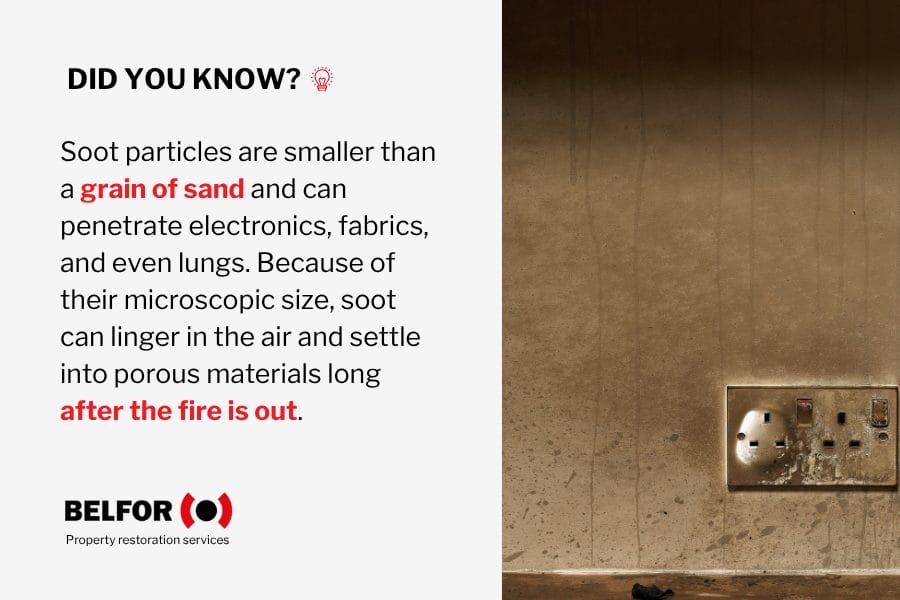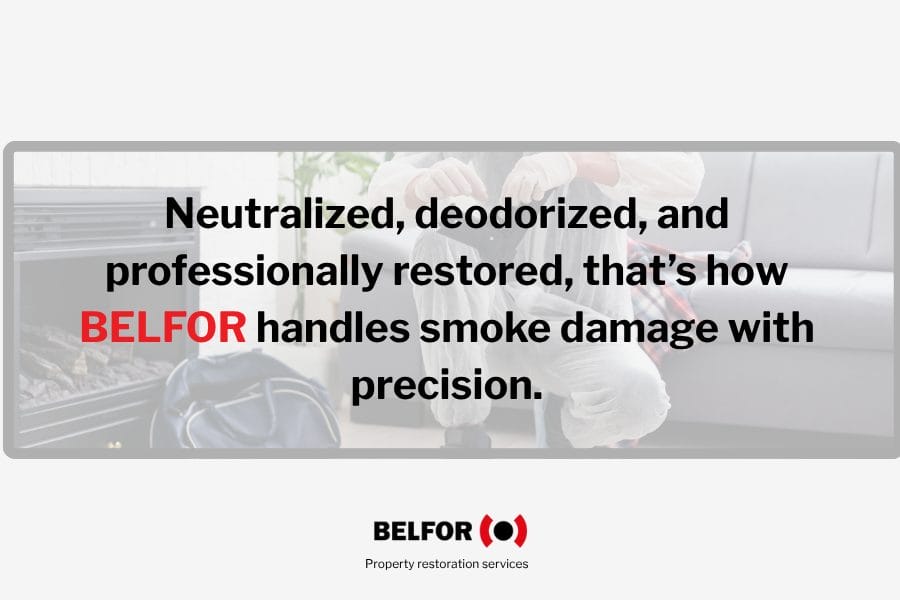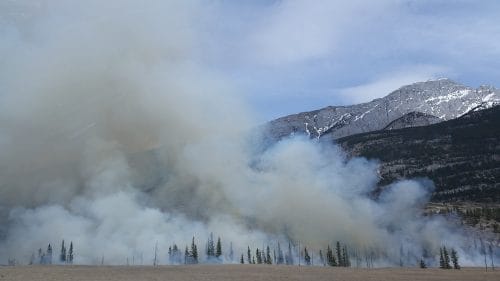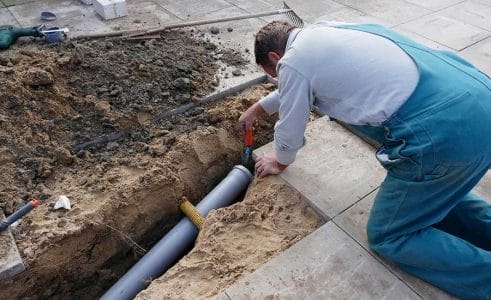What To Throw Away After Smoke Damage: Complete List

What To Throw Away After Smoke Damage: Key Takeaways
- Smoke damage extends beyond the fire zone. Smoke and heat from fires cause over $7 billion in property damage each year, often in areas untouched by flames
- Some items are never safe to keep. Discard all exposed food, medications, cosmetics, plastics, and soot-covered clothing to avoid health risks and contamination
- Don’t assume salvageable means safe. Clothing, electronics, and furniture may look fine but require professional smoke cleanup to be safe for reuse
- Lingering odors mean lingering toxins. Without air purification after a fire, the smoke odors and particles can remain in your home for weeks or months, impacting indoor air quality and well-being
- BELFOR gives you total support from day one. From emergency response and contents cleanup to air purification and insurance documentation, we handle everything, so you don’t have to
A fire may be over in minutes, but the danger doesn’t end when the flames are out.
Smoke damage is silent, toxic, and often overlooked, yet it can contaminate your food, seep into your clothing, and permanently ruin household items you thought were untouched.
Smoke and soot can spread throughout a home in under 30 seconds, affecting everything from furniture to medication, even in rooms far from the fire itself.
In this guide, we will cover:
- What items you should always throw away after smoke exposure
- Which belongings might be saved with professional cleaning after fire damage
- Insurance tips for replacing lost or damaged items
- How BELFOR helps you clean, restore, and recover safely
What You Should Always Throw Away After Smoke Damage
Smoke, soot, and heat can leave behind toxic residue that’s invisible to the eye but hazardous to your health.
The general rule? When in doubt, throw it out.
Below are the most common items of what to throw away after smoke damage.
1. Food Items: Perishable and Non-Perishable
Smoke, soot, and high heat can compromise food, even if the packaging appears intact.
Throw away:
- All open food, including spices, grains, and pantry staples
- Canned goods exposed to heat, soot, or fire extinguisher residue
- Food stored in cardboard, thin plastic, or wrap
- Refrigerator/freezer items if power was lost or odor is present
Pro tip: Don’t taste or test. If smoke got in the room, assume the food is contaminated.
2. Medications and Cosmetics
Medicines and skincare products may lose potency or become unsafe if exposed to heat and smoke.
Throw away:
- Prescription and OTC medications
- Vitamins and supplements
- Opened cosmetics and makeup kits
- Skincare or medical creams stored in plastic or damaged containers
3. Burned or Soot-Covered Clothing and Fabrics
Even with washing, smoke odors and particles may linger, especially in items worn close to the skin.
Throw away:
- Underwear, socks, baby clothing, and pajamas
- Fabrics with visible soot or smoke stains
- Melted or fire-damaged synthetics (can release toxins)
Pro tip: Items with a light odor may be restorable, but anything with soot or direct fire exposure should be discarded.
4. Paper Products and Books
Paper is highly porous and absorbs smoke instantly, often beyond salvage.
Throw away:
- Napkins, paper towels, tissues
- Smoke-damaged books, files, or coloring books
- Cardboard food packaging and gift boxes
Note: Important documents might be saved through specialty restoration, consult a certified provider.
5. Plastics and Rubber Materials
These materials trap odor and may release harmful fumes after smoke exposure.
Throw away:
- Kitchen utensils and food storage containers
- Baby items like bottles, pacifiers, and teething rings
- Rubber items that are warped, discolored, or sticky
Why Certain Things Need To Be Gone After Smoke Damage
Not everything that survives a fire is safe to keep. Smoke may not leave visible marks, but it deposits toxic chemicals, corrosive soot, and microscopic particles that can linger long after the flames are gone.
What makes smoke so dangerous?
- Toxins: Smoke contains harmful substances like carbon monoxide, formaldehyde, and polycyclic aromatic hydrocarbons (PAHs)
- Acidic residue: Soot is corrosive and can deteriorate materials within hours or days
- Airborne particles: Fine smoke particles can settle into fabrics, plastics, and paper, and may be inhaled long after the fire
Why throwing items away matters:
- Health risks: Exposure to smoke-contaminated items can cause headaches, nausea, respiratory issues, and skin irritation, especially in children, seniors, and those with preexisting conditions
- Recontamination: Keeping heavily affected items can reintroduce odors and toxins into a cleaned environment
- Insurance implications: Improper handling or delayed disposal could complicate your insurance claim or reduce reimbursement

What You Might Salvage From Smoke Damage
Some belongings can be restored, but only with the right equipment, techniques, and professional oversight.
Here’s what might be saved, but only under the right conditions.
Clothing and Upholstery
Clothing, curtains, and furniture fabrics are highly absorbent, and smoke particles can embed deeply into fibers. While some may seem unsalvageable, professional cleaning techniques can often restore them.
May be salvageable if:
- There is no visible soot, scorching, or fire damage
- The odor is present but not overpowering
- Items are cleaned using ozone treatment, thermal fogging, or dry cleaning
Pro tip: Washing machines can’t fully remove smoke odor. Let a certified fire damage restoration company determine what’s worth saving.
Electronics and Appliances
Smoke residue is corrosive and can damage internal wiring and circuit boards. Even small amounts of soot can reduce the lifespan or create a fire risk if the item is powered on too soon.
May be salvageable if:
- Devices were powered off and unplugged during the fire
- No external damage, melting, or heavy soot buildup is visible
- Inspected and cleaned internally by certified professionals
Be aware: Don’t plug in smoke-exposed electronics. Let a technician inspect and clean them first.
Hard-Surfaced Furniture
Wood, metal, glass, and sealed furniture may withstand smoke better than porous materials, but only if addressed quickly.
May be salvageable if:
- The surface is sealed (varnished or laminated)
- No visible charring or deep soot penetration
- Cleaned within 48–72 hours using approved products and techniques
Pro tip: Porous wood and unsealed finishes may trap odors, air purification and deep cleaning may still be required.

Can Insurance Help Replace Smoke-Damaged Items?
In most cases, yes, homeowners’ and renters’ insurance typically covers smoke-damaged contents.
That includes items lost to fire, soot, or heavy smoke exposure, depending on your policy limits and documentation.
To improve your chances of full reimbursement:
- Take clear photos of all damaged items before disposing of anything
- List approximate values or attach receipts, if available
- Work with a certified fire restoration company like BELFOR to document and inventory losses professionally
Pro tip: Your policy may cover both replacement cost and cleanup. Ask your provider about “contents coverage” and “loss-of-use” benefits.
How BELFOR Helps You Clean, Restore, and Recover
After smoke damage, you don’t just need cleaning, you need a full recovery solution.
At BELFOR, we understand how overwhelming fire and smoke damage can be, which is why we provide end-to-end support that goes beyond tips of what to throw away after smoke damage.
When you call BELFOR, you’re getting:
- 24/7 emergency response: We’re on-site fast to prevent further damage and start mitigation immediately, just call 800-856-3333
- Certified smoke and fire restoration experts: Our teams follow IICRC standards and use industrial-grade equipment for safe, effective results
- Contents cleaning, inventory, and disposal: We help sort, clean, and remove damaged items, and document everything for insurance
- Advanced odor and soot removal: We use ozone treatments, HEPA filtration, and thermal fogging to purify your space and eliminate toxic residues
- Insurance support from start to finish: We provide detailed estimates, itemized loss lists, and work directly with your adjuster
Whether you’re dealing with minor smoke exposure or widespread fire damage, BELFOR is your trusted partner in restoration.
What To Throw Away After Smoke Damage: FAQs
So if you’re still wondering what to throw away after smoke damage, here we listed some questions you might still need answers for.
What to throw away after smoke damage?
You should discard any open food, medications, cosmetics, burned clothing, soot-covered fabrics, and plastic or rubber items that have been exposed to heat.
These items may contain harmful toxins or be unsafe to use.
Can you keep canned food after smoke exposure?
No, even sealed cans can be compromised by high heat or soot. Smoke-damaged canned food should be thrown out to avoid contamination and health risks.
Is it safe to keep clothes that smell like smoke?
Only if professionally cleaned. Lightly affected items may be salvaged using ozone treatment or dry cleaning.
Anything with soot, heavy odor, or damage should be discarded.
How do I remove smoke smell from fabric or furniture?
Use professional methods like thermal fogging, ozone treatment, or HEPA air scrubbing.
Home laundering or DIY sprays typically won’t eliminate deep smoke odor.
How long does smoke smell last in a house?
Without proper air purification after a fire, the smoke odor can linger for weeks or even months. Professional cleaning is essential for full odor removal.
Does homeowners insurance cover smoke-damaged contents?
In most cases, yes, but only with proper documentation. Work with a certified fire restoration company to catalog losses and support your claim.
Can electronics be saved after smoke damage?
Possibly, but only if cleaned and inspected by a professional. Smoke residue can corrode internal parts, making devices unsafe or unreliable.
.jpg)


